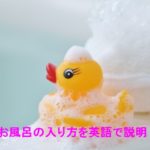こんにちは、ノ~チン(@NozomiJapanese)です!
今夜のご飯は手巻き寿司でした!
ってなことで、時季外れではありますが、今日は節分について英語で説明してみます♪
節分
さて、ではさっそく節分を英語で説明してみましょう!
節分とは
- 「節分」とは、その字のごとく「季節の分かれ目」という意味があり、季節が変わる前日のことを指しています。
“Setsubun” literally means “division of seasons” and indicates the day before a season changes. - もともと、節分は季節の数だけ存在し、立春、立夏、立秋、立冬それぞれの前日、つまり季節の最後の日のことを「節分」と呼んでいました。
Since we have four seasons in Japan, we used to call the last day of each season, spring, summer, autumn and winter “Setsubun”, a division of seasons. - 旧暦では、立春が元日を表していることから、節分は今でいう「大晦日」にあたります。
On the old Japanese lunar calendar, the beginning of spring was New Year so “Setsubun” was the New Year’s Eve. - このため、この日に一年の厄を払い、新年を迎えるための特別に儀式を行うようになりました。
Therefore, people started to have a special ritual on this day to purify evils of the past year and prepare for the new year. - そして、いつの間にかこの儀式を行う立春の前日が「節分の日」として定着したそうです。
The day before the beginning of spring that the ritual was held became widely known as “Setsubun” the division of the season. - 「節分」は通常2月3日前後です。
“Setsubun” usually falls on somewhere around February third.

節分にすること①:豆まき
- 「節分」には、新年(旧暦の新年)を迎えるために、邪気を祓い、新年を幸多き年として迎えられるよう、厄払いを行うようになりました。
On “Setsubun”, the division of the season, people started to hold a ritual to purify evils and prepare for a happy new year. - これが、豆まきです。
The ritual is throwing beans. - 家庭で豆をまきます。
People throw beans at home. - 日本各地の神社でも「節分祭」という行事があり、豆まきが行われます。
At many Shinto shrines throughout Japan, they also have throwing beans festivals. - 「鬼は外!福は内!」と言いながら豆をまきます。
People say “Oni ha soto! Fuku ha uchi!” meaning “Get demon out of the house! Invite happiness into the home!”
- 「鬼」とは、邪気や厄の象徴です。
Demon is the symbol of bad luck or misfortune. - 昔は、災害や病、飢饉などの恐ろしい出来事は鬼の仕業と考えられていました。
People used to believe that bad incidents such as disaster, illness and famine were the acts of demons. - 豆まきの豆は、炒った豆を使います。
People roast beans before throwing. - これは、まいた後に拾い残した豆から芽が出てこないように(悪い鬼が芽を出さないように)、という理由からです。
This is because left behind beans will not bud (meaning demon will not rise). - また、炒った豆は「福豆」と呼ばれ、豆まきの後には自分の年の数、または自分の年の数 + 1個の豆を食べます。
The roasted beans are called “Lucky Beans”. People pick up the beans after throwing them and eat the same number of beans as their age or one more of their age. - 「年齢と同じ数だけ福を身体に取り入れる」という意味があります。
That means taking in the good luck to body as many as their age.

節分にすること②:恵方巻きを食べる
- 節分には、恵方巻きという太巻き寿司を食べる習慣があります。
We eat sushi called “Eho maki” or “Good luck direction roll” on Setsubun. - 「恵方」というのは、その年の神様がおられる方角のことを言います。
“Eho” means the direction where the god of the year resides. - 恵方巻きを食べるときの注意点が3つあります。
There are three important manners while you eat “Eho maki”. - その①:その年の恵方に向かって食べること。
Manner 1: Face “Eho” the good luck direction while you eat. - その②:食べ終わるまで無言で食べること(= 神様によい年になりますように、とお願いをしながら食べるから)。
Manner 2: Do not speak while you eat (as you are asking god for a good new year while you are eating). - その③:切らずに、丸ごとかぶりつくこと(= 縁を切らないために)。
Manner 3: Do not cut the roll. Bite and eat the whole thing (so the good relationship will not be cut).
重要な用語
| 日本語 | 英語 | 発音 |
| 季節の分かれ目 | division of seasons | |
| 大晦日 | New Year’s Eve | |
| 儀式 | ritual | |
| 豆まき | throwing beans | |
| 鬼 | demon | |
| 象徴 | symbol | |
| 災害 | disaster | |
| 飢饉 | famine | |
| 出来事 | incident | |
| 炒る | roast | |
| 芽が出る | bud | |
| 取り入れる | take in | |
| 恵方巻き | “Eho maki” or “Good luck direction roll” | |
| 向かって | face | |
| 丸ごと | whole thing | |
まとめ
という訳で、今日は「節分」について見てきました。
各季節の分かれ目のことを節分と呼んでいたのが、旧暦の正月の前日、つまりは大みそかに当たる2月の節分がいつの間にか「節分」として定着し、新年を迎えるのに特別な儀式(豆まきや恵方巻きを食べる)をするようになった、ということでした。
オリンピックももう間近ですし、外国人に説明するときのために、ぜひぜひ英語で言えるようになっておきましょう(*´∀`*)b!
『春分の日:海外ではどうなの?えぇ、ビックリ( ゚Д゚)?!』では各国の春分について書いています。意外な事実が分かっておススメの記事です(๑´ڡ`๑)。
それでは、今日はこれにて!ノ~チンチャン♪♪
















